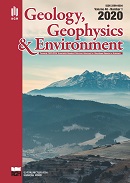Fractured clasts in the Mt Currie Conglomerate at Kata Tjuta (Central Australia): evidence of Early Cambrian earthquakes?
DOI:
https://doi.org/10.7494/geol.2020.46.1.29Keywords:
fractured clasts, earthquakes, Kata Tjuta, AustraliaAbstract
Lower Cambrian Mt Currie conglomerate at Kata Tjuta bornhardts (Central Australia) bears numerous fractured clasts. Clast-cutting fractures are restricted to particular clasts, the matrix of the conglomerate is not fractured. The fractures are tectonic joints of two sets. The joints were formed due to either seismic or aseismic deformation. In the former case, the fractures may result from Early Paleozoic earthquakes.Downloads
References
Acharyya S.S. & Mondal T.K., 2019. Stress enhanced tensile fractures in elliptical clast in conglomerate. Journal of Structural Geology, 122, 81–88.
Bradley D.C. & Bradley L.M., 1986. Teconic significance of the Carboniferous Big Pond Basin, Cape Breton Island, Nova Scotia. Canadian Journal of Earth Sciences, 23, 2000–2011.
Cuong N.Q., Tokarski A.K., Świerczewska A., Zuchiewicz W.A. & Yem N.T., 2013. Late Tertiary tectonics of the Red River Fault Zone: Structural evolution of sedimentary rocks. Journal of Geodynamics, 69, 31–53.
Dor O., Rockwell T.K. & Ben-Zion Y., 2006. Geological observations of damage asymmetry in the structure of the San Jacinto, San Andreas and punchbowl faults in Southern California: possible indicator for preferred rupture propagation direction. Pure and Applied Geophysics, 163, 301–349.
Eildelman A. & Reches Z., 1992. Fractured pebbles – a new stress indicator. Geology, 20, 307–310.
Ernston K., Rampino M. R. & Hiltl M., 2001. Cratered cobbles in Triassic Bundsanstein conglomerates in North Eastern Spain: An indicator of shock deformation in the vicinity of large impacts. Geology, 29, 11–14.
Jerzykiewicz T. & Van Helden D.R., 1984. Preliminary observations on pock Marks and fractured Peebles in the Upper Cretaceous and Paleocene of the Central Alberta Foothills near Hinton. Papers of Geological Survey of Canada, 84-1B, 263–267.
Kupsch W.O., 1955. Drumlins with jointed boulders near Dollard, Saskatchewan. Geological Society of America Bulletin, 66, 327–338.
Kübler S., 2013. Active tectonics of the Lower Rhine Graben (NW Central Europe) based on new paleoseismological constraints and implications for coseismic rupturę processes in unconsolidated gravels. Ludwig-Maximilians-Universität München [Ph.D. thesis].
Kübler S., Friedrich A.M., Gold R.D. & Strecker M.R., 2018. Historical coseismic surface deformation of fluvial gravel deposits, Schafberg fault, Lower Rhine Graben, Germany. International Journal of Earth Sciences, 107, 571–585.
Little T.A., 1995. Brittle deformation adjacent to the Awatere strike-slip fault in New Zealand: Faulting patterns, scaling relationships, and displacement partitioning. Geological Society of America Bulletin, 107, 1255–1271.
Meyer M.C., Wiesmayr G., Brauner M., Häusler H. & Wangda D., 2006. Active tectonics in Eastern Lunana (NW Bhutan): Implications for the seismic and glacial hazard potential of the Bhutan Himalaya. Tectonics, 25, 1–21.
Mondal T.K. & Acharyya S.S., 2018. Fractured micro-granitoid enclaves: A stress marker. Journal of Structural Geology, 113, 33–41, https://doi.org/10.1016/j.jsg.2018.05.011.
Montes C., Hatcher Jr., R.D. & Restrepo-Pace A., 2005. Tectonic reconstruction of the northern Andean blocks: oblique convergence and rotations derived from the kinematics of the Piedras-Girardot area, Colombia. Tectonophysics, 399, 221–250.
Nieć M., Mochnacka K. & Sass-Gustkiewicz M., 2016. Geologia miejsc niezwykłych: Uluru, Kata Tjuta, Kings Canyon w Australii [Geology of the unique places of Uluru, Kata Tjuta and Kings Canyon in Australia]. Przegląd Geologiczny, 64, 5, 299–305.
Phan D.P., Tokarski A.K., Świerczewska A., Strzelecki P.J., Waliczek M., Krąpiec M. & Cuong N.Q., 2019. Neotectonic (Miocene to recent) vertical movements in the Lao Cai Basin (Red River Fault Zone, Vietnam): An approach to seismic hazard assessment. Journal of Asian Earth Sciences, 181, 103885, https://doi.org/10.1016/j.jseaes.2019.103885.
Ramsay D.M., 1962. The Highland Boundary Fault: reverse or wrench fault? Nature, 195, 1190–1191.
Ramsay D.M., 1964. Deformation of pebbles in the lower Old Red Sandstone conglomerates adjacent to the Highland Boundary Fault. Geological Magazine, 101, 228–248.
Raymond O.L., Liu S., Gallagher R., Zhang W. & Highet L.M. 2012. Surface Geology of Australia 1:1 million scale dataset, 2012 edition. Geoscience Australia, Canberra.
Sandiford M., Hand M. & McLaren S., 2001. Tectonic feedback, intraplate orogeny and the geochemical structure of the crust: a central Australian perspective. [in:] Miller J.A., Holdsworth R.E., Buick I.S. & Hand M. (eds.), Continental Reactivation and Reworking, Geological Society, London, Special Publications, 184, The Geological Society of London, 195–218.
Tanner W.F., 1976. Tectonically significant pebble types: Sheared, pocked and second-cycle examples. Sedimentary Geology, 16, 69–83.
Tokarski A.K., Márton E., Świerczewska A., Fheed A., Zasadni J. & Kukulak J., 2016. Neotectonic rotations in the Orava-Nowy Targ Intramontane Basin (Western Carpathians): An integrated palaeomagnetic and fractured clasts study. Tectonophysics, 685, 35–43.
Twidale C.R., 2010. Uluru (Ayers Rock) and Kata Tjuta (The Olgas): Inselbergs of Central Australia. [in:] Migoń P. (ed.), Geomorphological Landscapes of the World, Springer Science+Business Media B.V, 321–332.
Trevelyan W.C., 1845. On fractured boulders found at Auchmithie near Arbroath. Quaternary. Journal of the Geological Society, 1, 147–148.
Young D.N. Duncan N., Camacho A., Ferenczi P.A. & Madigan T.L.A., 2002. Ayers Rock, Northern Territory Geological Survey (2nd ed.). Sheet SG 52-8, 1:250 000. Geological Map Series Explanatory Notes, Darwin.
Downloads
Published
Issue
Section
License
Authors have full copyright and property rights to their work. Their copyrights to store the work, duplicate it in printing (as well as in the form of a digital CD recording), to make it available in the digital form, on the Internet and putting into circulation multiplied copies of the work worldwide are unlimited.
The content of the journal is freely available according to the Creative Commons License Attribution 4.0 International (CC BY 4.0)










